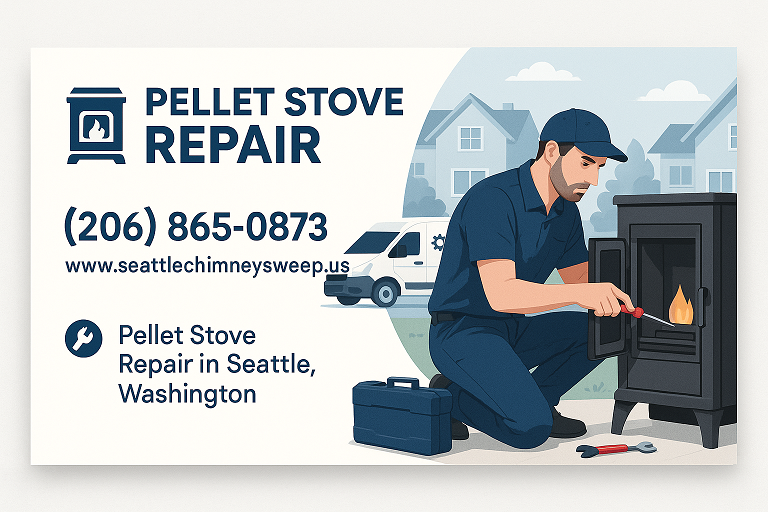There’s something deeply satisfying about a pellet stove on a cold day. The soft warmth, the crackling hum it just feels like home. But if you want your stove to keep doing its job without costing you a fortune in repairs, a little regular maintenance goes a long way. Don’t worry, you don’t need to be a technician or a chimney sweep to do most of this. A few smart habits can help you avoid breakdowns, boost efficiency, and even stretch the life of your stove for years. If you’re using a stove through Seattle’s long damp seasons, this one’s for you. And hey these same tips can save you from an unexpected call for pellet stove repair in Seattle.
Dirty Stove, Big Problems: Why Cleaning Matters
Pellet stoves are efficient little machines, but they get dirty fast. That fine ash, leftover pellets, and soot buildup? It may look harmless, but over time it gums up key parts especially the burn pot, blower fans, and exhaust.When airflow gets restricted, your stove has to work harder. It may burn less efficiently, kick off weird smells, or even shut down entirely.
Here’s what I clean regularly (and how often):
| Component | How Often to Clean | Why It Matters |
| Burn pot | Every 2–3 days of use | Keeps airflow steady and burns pellets cleanly |
| Ash pan | Weekly or as needed | Prevents ash overflow that can affect performance |
| Glass window | Weekly | Just for visibility—and so it doesn’t stain long-term |
| Heat exchanger | Monthly | Keeps heat output high |
| Vent pipe/exhaust | Monthly or every ton used | Avoids blockages, improves air quality and safety |
You can knock out most of this with a shop vac and a soft brush. Just remember to let everything cool before diving in.
The Power of the “Lazy Day” Inspection
Every so often, especially during peak season, set aside 15–20 minutes for what I call the lazy day inspection. You don’t need tools or a manual just your eyes, ears, and nose.
Here’s what to check:
- Does the fire look steady? Weak or flickering flames might mean your burn pot is clogged.
- Hear any strange noises? Grinding or whining could mean your auger or blower fan is working overtime or failing.
- Smell smoke or a burnt odor? Could be an exhaust leak or excess ash burning off.
If you catch these signs early, you might save yourself from a much bigger issue later.
Replacing Parts Before They Quit on You
It might sound strange, but one of the best ways to avoid repairs is to replace small parts before they break. Think of it like changing the oil in your car you don’t wait until the engine seizes, right?
Some of the most common wear-and-tear parts include:
- Gaskets: These rubbery seals around your door and ash pan wear out over time. Replace them yearly or if you see cracks.
- Igniters: If your stove doesn’t light consistently, or takes too long to get going, your igniter might be fading. Easy to replace and way cheaper than calling a tech.
- Combustion blower fans: These keep air moving in and exhaust going out. If you hear rattling or weak airflow, it might be time.
Most of these parts are inexpensive and easy to find online. And with a few YouTube videos and a screwdriver, many homeowners can handle basic swaps themselves.
Don’t Forget the Fuel: Quality Pellets Matter
Here’s something people often overlook: not all pellets are created equal. While cheap pellets might save you a few bucks per bag, they usually leave behind more ash and residue—clogging your system faster and causing more frequent cleanings or even mechanical issues. That’s why it’s smart to use a mobile app to track pellet quality, maintenance schedules, and system performance helping you avoid problems before they start.
Look for:
- Low ash content (less than 1%)
- High BTU rating (more heat per pellet)
- Consistent size and shape (feeds better through the auger)
It’s also a good idea to store your pellets in a dry, sealed container. Moisture is the enemy here it can swell your pellets and jam up your stove in a hurry.
Real Talk from a Pro
“The best way to save money on pellet stove repairs? Don’t wait for something to break. A half hour of cleaning can save you hundreds down the line.”
— Jesse L., Stove Tech and Installer, Spokane, WA
That advice stuck with me the first time I heard it. It’s simple, but true.
Bonus Tip: Get a Yearly Pro Check-Up
Even if you’re a DIY champ, it’s smart to have a certified tech check your stove once a year usually right before winter hits hard. They’ll inspect the wiring, pressure settings, chimney vent, and make sure everything’s up to safety standards. Think of it like a seasonal tune-up for your heating system.Especially in damp, coastal places like Seattle, where moisture and ash can mix to create a corrosive mess inside your exhaust system, a yearly inspection is one of the smartest ways to avoid long-term issues especially those that start in your venting or chimney liner in Seattle.
Conclusion: A Little Effort Goes a Long Way
Preventative pellet stove maintenance isn’t glamorous, but it’s one of the easiest ways to save real money and keep your home cozy all winter long. Think of it like brushing your teeth boring in the moment, but so worth it in the long run.Clean it regularly, keep an eye on how it’s running, replace small parts before they become big problems, and stick to high-quality fuel. Add a yearly inspection to the mix, and you’ll be way ahead of the game.Not only will your stove run better and last longer, but you’ll also avoid the hassle and cost of emergency pellet stove repair in Seattle.
Read More: Chimney Sweep
